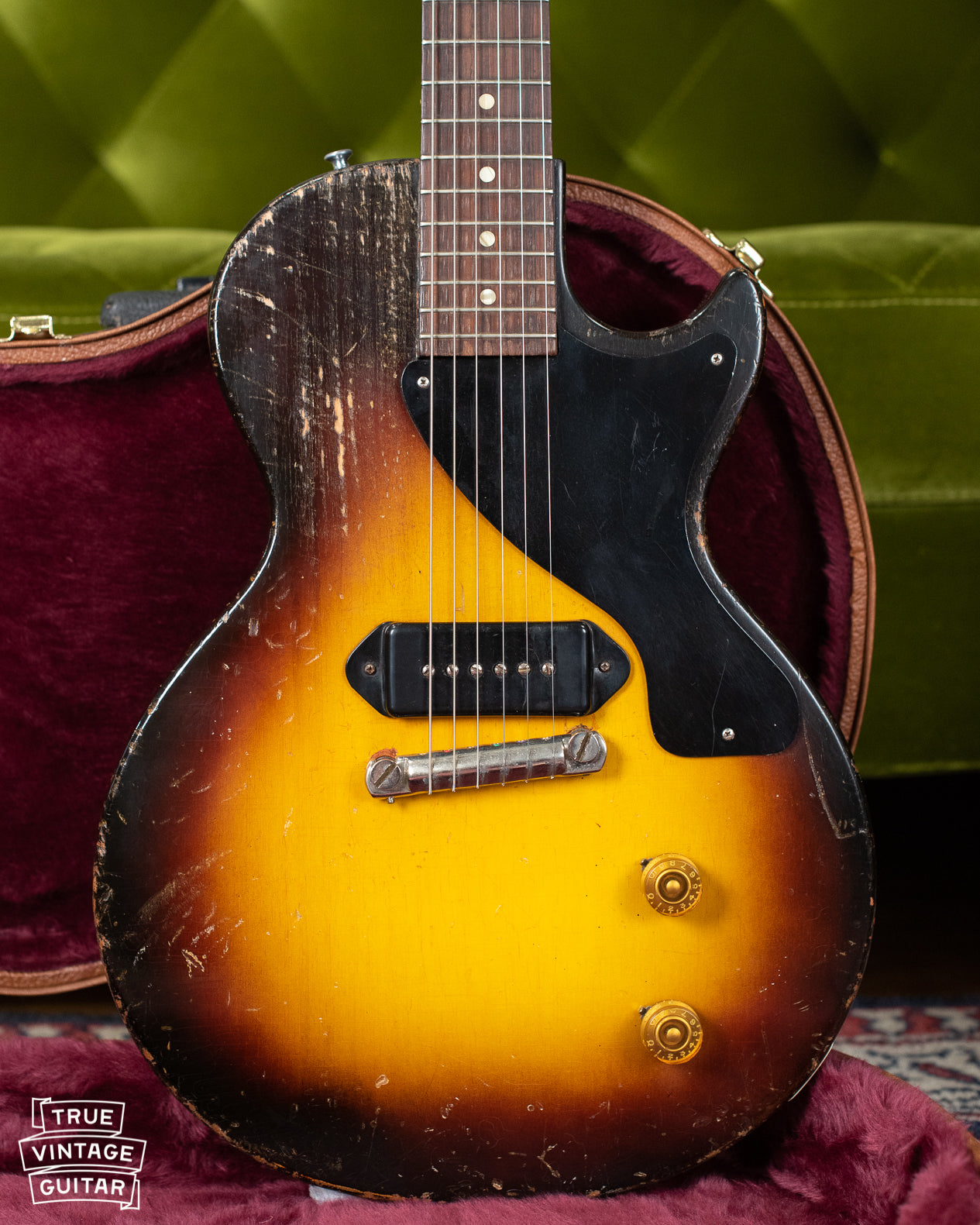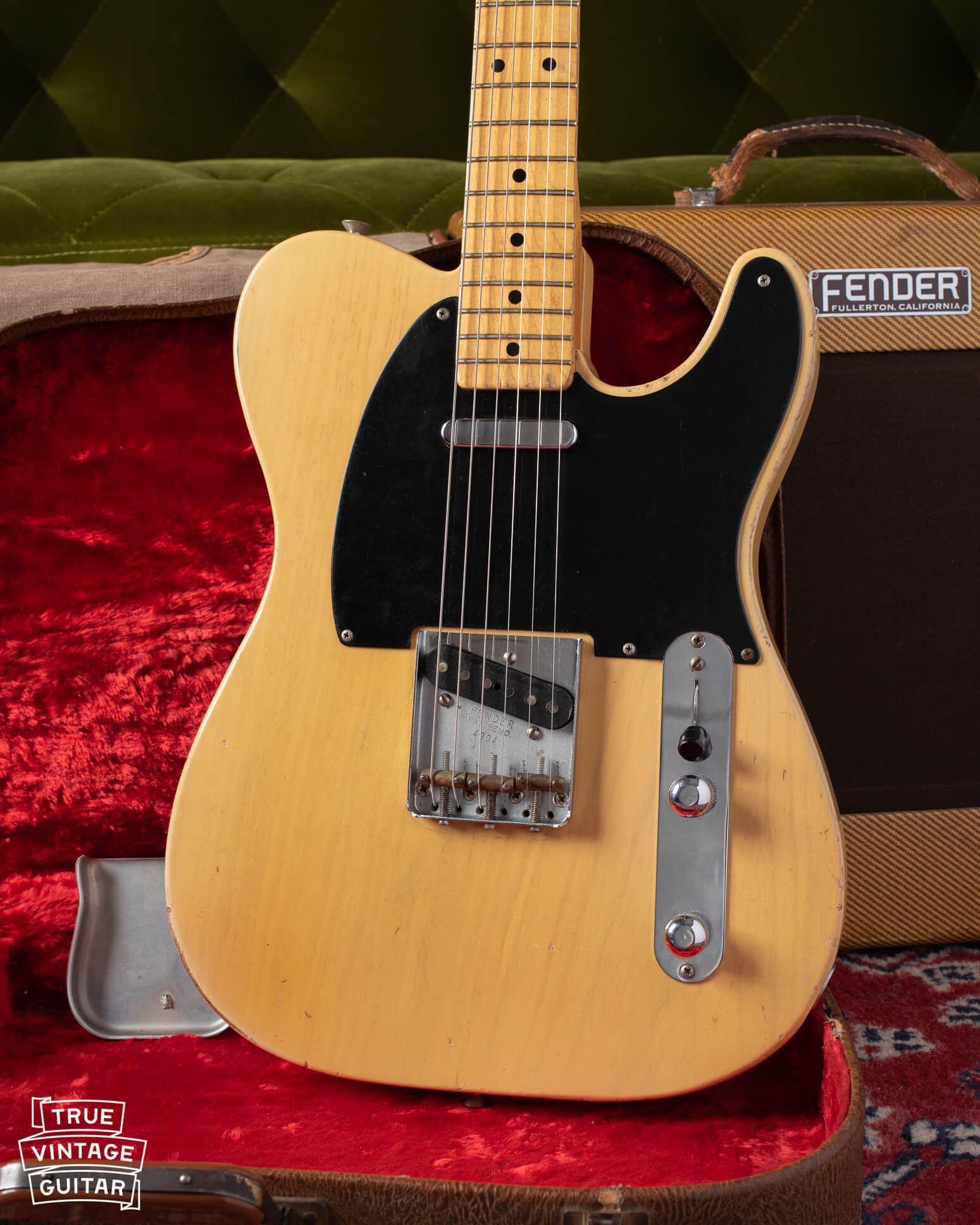I saw an old amp on Craigslist in Tuscaloosa the other day. It was a Silvertone 1472 sporting about 10 watts or so and a 12" speaker. I was heading to Tuscaloosa on business that day so I figured I would inquire about it. Unfortunately I was about 10 minutes too late.
The seller was very nice and asked what else I was interested in. I told him I like anything old and made in America. He said he had an old Kay flat top that had a body made by Gibson. I thought to myself, "I've heard that before."
The body was not made by Gibson but that didn't matter to me. This is a mid 1950s Kay (Harmony) Jumbo (actual model? I dunno. Maybe just Kraftsman). It was made in Chicago and features a solid Spruce top, solid one piece flame Maple back and veneer sides. It has 17" wide hips (a regular dreadnought is 16") and has ladder bracing. It is original save for the Guild bridge added sometime long ago. It even came with the original Kluson tuners!
I was drawn to this guitar for three reasons: the size, appointments and the FLAME MAPLE BACK! This is an absolutely beautiful slab of maple. They didn't even cut it in half and book match it. It is just one solid piece of sexy Maple.
She came to me in pretty good shape except that the neck was falling out and there was no nut or saddle. I was very excited to have another neck reset project. My last one didn't go so well but I learned a lot from it. You can read all you want about it but there is not substitute for just doing it. I highly suggest it if you are so inclined and have a suitable subject (ie not Gibson).
This is a dovetail joint. It requires skilled craftsmanship to make and fit the neck to the guitar at just the right angle. It takes a lot more time and human attention than a bolt on neck. Dovetail joints are not easily made by machines. They are a sign of old world craftsmanship. Do you own a Taylor? Your guitar probably does not have one of these.
I was really excited to see no gaps when I was done! These are crappy cell phone shots. I forgot to take real pictures. I didn't want any good evidence in case it went bad.
Another interesting feature (or lack thereof) is the absence of a truss rod. Maybe it was just an attempt to save money. They accounted for this by making the neck a monster. It is by far the biggest neck I have ever seen. It really gives it that 40s and 50s feel. The neck is straight as an arrow so I guess they called Time's bluff.
The seller was very nice and asked what else I was interested in. I told him I like anything old and made in America. He said he had an old Kay flat top that had a body made by Gibson. I thought to myself, "I've heard that before."
The body was not made by Gibson but that didn't matter to me. This is a mid 1950s Kay (Harmony) Jumbo (actual model? I dunno. Maybe just Kraftsman). It was made in Chicago and features a solid Spruce top, solid one piece flame Maple back and veneer sides. It has 17" wide hips (a regular dreadnought is 16") and has ladder bracing. It is original save for the Guild bridge added sometime long ago. It even came with the original Kluson tuners!
I was drawn to this guitar for three reasons: the size, appointments and the FLAME MAPLE BACK! This is an absolutely beautiful slab of maple. They didn't even cut it in half and book match it. It is just one solid piece of sexy Maple.
She came to me in pretty good shape except that the neck was falling out and there was no nut or saddle. I was very excited to have another neck reset project. My last one didn't go so well but I learned a lot from it. You can read all you want about it but there is not substitute for just doing it. I highly suggest it if you are so inclined and have a suitable subject (ie not Gibson).
This is a dovetail joint. It requires skilled craftsmanship to make and fit the neck to the guitar at just the right angle. It takes a lot more time and human attention than a bolt on neck. Dovetail joints are not easily made by machines. They are a sign of old world craftsmanship. Do you own a Taylor? Your guitar probably does not have one of these.
I was really excited to see no gaps when I was done! These are crappy cell phone shots. I forgot to take real pictures. I didn't want any good evidence in case it went bad.
The wife was kind enough to let me turn the apartment into a repair shop. It was a mess and still kind of is. This is a shot of me cutting the me bone nut. It was my first full nut made from scratch. I was happy with the result since it was my first try. I will definitely do some things differently next time.
This is an interesting guitar because it has a 26" scale length. That is the distance from the saddle (the white piece on the bridge) to the nut (the white piece at the top of the neck). The standard scale length for a Gibson is 24 3/4" and the standard Martin scale is 25 1/2". This is significant in both the way it plays and sounds. A longer scale means that the strings must be tighter in order to sound the note. This usually makes for a louder and more difficult to play instrument (on average). The tighter the string is the more difficult it is to push the string down to the fret. Needless to say, this thing is a hoss to play and sounds great!
I really like the peghead overlay on this one. They used a celluloid overlay and carved and painted the detail and logo with white and gold paint. I was talking with a friend about this guitar and he made a good point about how the peghead is very underused and plain on most guitars. I agreed and thought that this was one of the most beautiful headstocks I have ever seen.
Enough talk. Let's pick.










